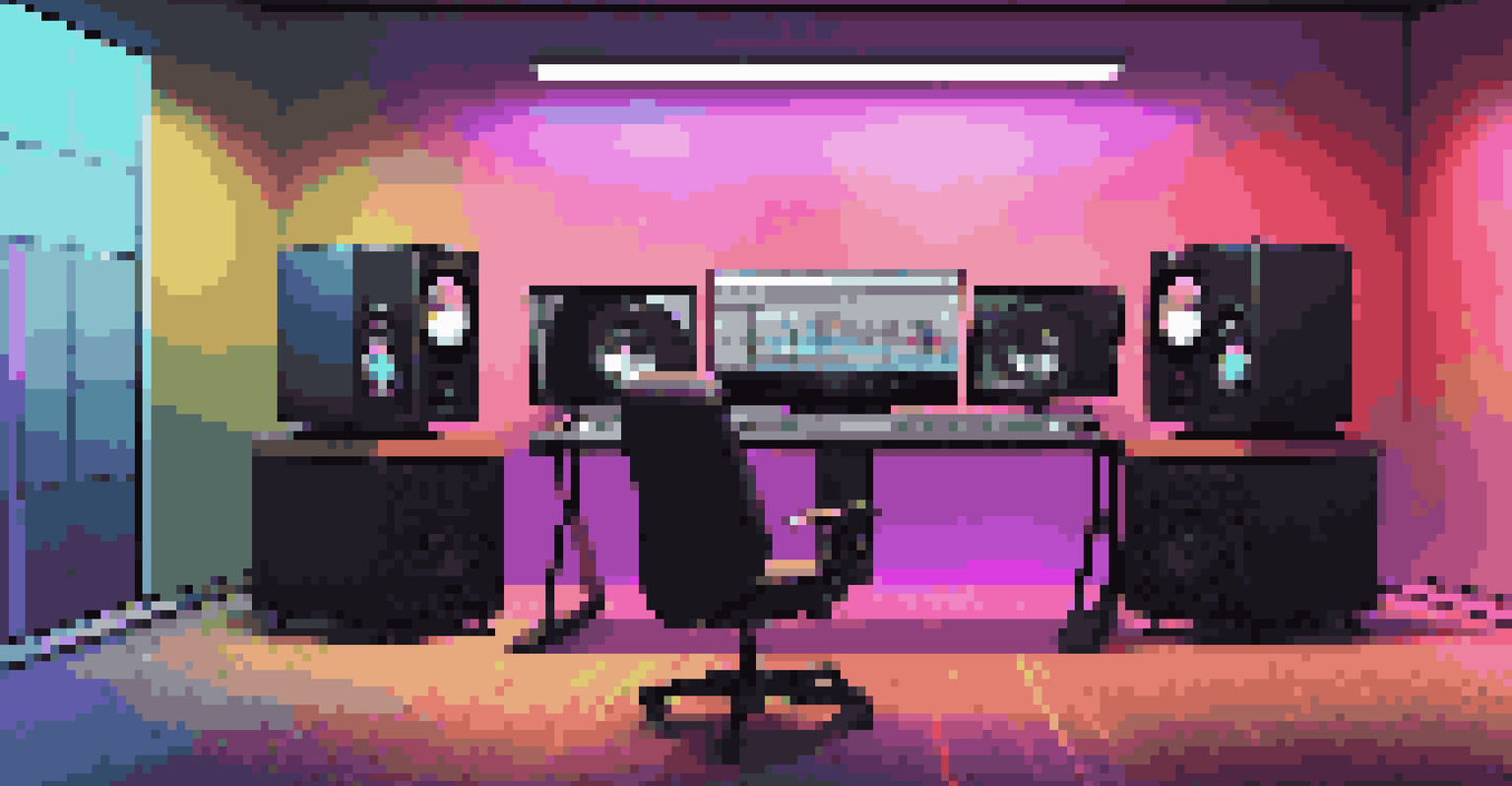The History of Sound Technology: From Phonographs to Digital

The Birth of Sound Recording: Phonographs Begin the Journey
In the late 19th century, Thomas Edison introduced the phonograph, a revolutionary device that could both record and reproduce sound. This marked the first time people could listen to a recording of their own voice or music played back. The phonograph used a simple cylinder wrapped in tinfoil to capture sound vibrations, a groundbreaking concept that sparked the imagination of inventors and musicians alike.
The phonograph is the most important invention since the printing press.
Soon after, Emile Berliner improved upon Edison's design with his gramophone, which used flat discs instead of cylinders. This shift not only simplified the process of sound recording but also made it easier to mass-produce music. The introduction of these technologies laid the foundation for the music industry as we know it today, allowing for the distribution of recorded music to a wider audience.
As phonographs and gramophones became popular, they transformed social gatherings and entertainment. Families would gather around these devices to enjoy music, storytelling, and other performances, fostering a sense of community through shared listening experiences. This era marked the beginning of sound technology's impact on culture and society.
The Rise of Magnetic Tape: A New Era of Recording
In the 1930s, magnetic tape emerged as a game-changer in the world of sound technology. This new medium allowed for longer recording times and higher sound quality, revolutionizing how audio was captured and shared. The introduction of reel-to-reel tape recorders opened up new possibilities for musicians, broadcasters, and filmmakers alike.

Magnetic tape not only improved the fidelity of recordings but also introduced the concept of editing sound. Producers could now splice together different takes, allowing for greater creativity and precision in music production. This flexibility led to the birth of new genres and styles, as artists began experimenting with sound in ways that were previously impossible.
Phonographs Revolutionized Sound
The introduction of the phonograph and gramophone transformed how people recorded and listened to music, laying the groundwork for the modern music industry.
The popularity of magnetic tape continued to grow throughout the 20th century, eventually leading to the development of cassette tapes in the 1960s. This portable format made it easier for people to enjoy music on the go, solidifying the influence of sound technology on everyday life and paving the way for the music industry's evolution.
The Digital Revolution: Turning Sound into Data
The 1980s ushered in the digital revolution, fundamentally altering the landscape of sound technology. With the advent of digital audio, sound could now be represented as data, allowing for unprecedented levels of clarity and manipulation. This shift not only enhanced audio quality but also made it easier to store and share music.
Music can change the world because it can change people.
Compact discs (CDs) became a staple of the music industry during this time, offering a significant upgrade over vinyl and cassette tapes. The ability to skip tracks and enjoy near-perfect sound quality contributed to the rapid adoption of CDs, making them a household item. This period marked a significant transition in how music was consumed, moving towards a more digital-centric model.
As digital technology continued to advance, new formats such as MP3 emerged, drastically reducing file sizes and making music even more accessible. This evolution paved the way for online music distribution and streaming services, changing the way we experience sound forever. Suddenly, listeners had the world of music at their fingertips, leading to a democratization of music consumption.
The Era of Streaming: Sound Technology at Our Fingertips
The 2000s saw the rise of streaming services, fundamentally transforming how we access and enjoy music. Platforms like Spotify and Apple Music made it possible for users to listen to millions of songs without the need to purchase individual albums. This shift not only changed consumer behavior but also reshaped the music industry itself, creating new revenue models and opportunities for artists.
Streaming services leverage sophisticated algorithms and data analytics to curate personalized playlists, keeping listeners engaged and discovering new music. This customization aspect has led to a more interactive experience, as users can explore genres and artists tailored to their tastes. The convenience of streaming has made music an integral part of daily life, accessible anytime and anywhere.
Streaming Changed Music Access
The rise of streaming services in the 2000s made millions of songs accessible at users' fingertips, reshaping consumer behavior and the music industry.
However, the rise of streaming has also sparked debates about artist compensation and the value of music. Many musicians express concerns over how royalties are calculated and distributed, prompting discussions about the sustainability of the industry. As we navigate this new landscape, it's clear that sound technology continues to shape our relationships with music and the artists behind it.
Emerging Technologies: AI and Sound Creation
As we move further into the 21st century, emerging technologies like artificial intelligence (AI) are beginning to play a significant role in sound creation and production. AI algorithms can analyze vast amounts of data to generate new music, offering artists unique tools for inspiration and composition. This innovation is pushing the boundaries of creativity, allowing musicians to explore new sonic landscapes.
The use of AI in sound technology also extends to improving audio quality and enhancing the listening experience. For instance, AI-driven tools can automatically adjust sound settings for optimal playback, ensuring that listeners enjoy the best possible audio experience. This technology not only benefits casual listeners but also professional producers looking to refine their tracks.
While some may view AI-generated music as a threat to traditional artistry, others see it as an exciting collaboration between human creativity and machine learning. As artists embrace these new tools, we can expect to see a fascinating blend of organic and synthesized sound, reflecting the evolving nature of music in our digital age.
The Role of Sound Technology in Film and Media
Sound technology has played a crucial role in shaping the film and media landscape since the advent of synchronized sound in the late 1920s. The introduction of sound in films transformed the way stories were told, adding depth and emotion to the visual experience. This innovation paved the way for iconic moments in cinema, where sound effects, dialogue, and music worked together to enhance storytelling.
Advancements in sound technology have continued to evolve alongside film, with innovations such as surround sound and Dolby Atmos creating immersive audio experiences for viewers. These technologies allow filmmakers to manipulate sound in ways that place the audience right in the heart of the action, enhancing the emotional impact of scenes. The marriage of sound and visuals has become essential in creating compelling narratives.
AI is Shaping Sound Creation
Emerging AI technologies are now enhancing music production and audio quality, creating new opportunities for artists while blending human creativity with machine learning.
As streaming platforms gain popularity, the demand for high-quality sound in media consumption has also increased. Audiences now expect a cinematic experience from their favorite shows and movies, prompting creators to invest in advanced sound technology. This emphasis on sound quality not only elevates the viewing experience but also highlights the importance of sound technology in modern storytelling.
Looking Ahead: The Future of Sound Technology
As we look to the future, sound technology continues to evolve at a rapid pace, shaping how we create, share, and experience audio. Innovations such as spatial audio and immersive soundscapes are on the horizon, promising to revolutionize how we perceive sound. These advancements will likely lead to new artistic expressions and enhance the way we engage with music and media.
The rise of virtual and augmented reality (VR and AR) also presents exciting opportunities for sound technology. Imagine stepping into a virtual concert where sound envelops you from all directions, or experiencing a film where the audio reacts dynamically to your movements. These immersive experiences could redefine how we interact with entertainment and storytelling.

Ultimately, the future of sound technology is bright and full of potential. As artists, technologists, and listeners continue to explore new frontiers, we can expect to witness even more innovative ways to create and appreciate sound. With each advancement, we are reminded of the profound impact sound technology has on our lives and culture.